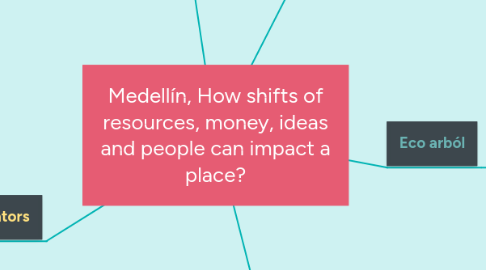
1. Escalators
1.1. High up on the hill-side of Cumuna 13 is an area that was plagued by violence and poverty, once a stronghold for guerrilas
1.2. Its 12,000 residents had to hike the equivalent of 28 stories, after scraping a living in the city.
1.3. The solution?
1.4. A 384 meter orange roofed escalator that scales the mountain in 6 sections. The project was finished in 2011
1.5. The development has been credited as a model for urban planning, however it is the social impacts that must be viewed.
1.6. Its an indigenous example of how transport can unite social classes. Since the escalators have been used it has brought peace and pride to the community, the control is now within the hands of community members.
2. External forces
2.1. 1991 was a key turning point for the country, it was a moment were the situation couldn't possibly get worse-there was a glimmer of hope.
2.1.1. 70 delegates composed of; ex-guerrillas, Indian leaders, businessmen, social leaders, labor leaders, peasants, clerics and academics.
2.2. The country's constitution that year took measures to combine ideas and viewpoints from a historically diverse collective.
2.2.1. The new constitution gave greater independence to elect their own leaders, this meant offering more control over urban development to local people with local knowledge and expertise.
3. Escobars: Medellin without slums
3.1. It is to grossly distort history without considering the role one of the most powerful and violent drug lords in shaping the urban city.
3.1.1. In 1982, Pablo initiated his politically motivated campaign, it aimed to rid the city of its slums and provide a "life of noble dignity"
3.2. He was briefly a representative, as he was expelled for his drugs operations. The symbolic gesture was the first attempt to provide change for the poor from within.
3.2.1. Fundamentally, he provided the comunas a voice for political change and a vehicle for their voices to be heard. Escobar’s legacy, in planning terms, was this transformation of the spatial divide between formal and informal territories, between rich and poor, into a violent opposition of territories
4. Eco arból
4.1. A tall hi-tech tree that helps purify 22,000 cubic meters of air every hour, by removing C02 and traffic toxins
4.1.1. Built by ConTreeBute and engineered by Italians
4.1.2. The implementation of useful and innovative ideas helps outsiders feel more connected to place, as they gravitate towards the various socio-environmental rewards offered to the citizens.
5. Medellin Governance
5.1. Key to their approach was a commitment to the public realm as a truly shared space, and a faith that they could transform Medellín’s public spaces from sites of segregation and warfare into spaces where communities would come together.
5.1.1. On many projects, the design team worked with a “man on the ground” – a community representative who was mouthpiece and interpreter for the community in which interventions were being proposed.
5.2. In 1998, it became constitutional law in Colombia that every municipality had to develop a masterplan, and that planning could not happen without social participation.
5.2.1. The mayor Fajardo and the architect Alejandro Echeverri were essential figures towards the momentus changes that were to occur. Fajardo surrounded himself by a team of experts and specialists at his Urban Development Corporation (EDU), working with architects, planners, engineers and sociologists to collectively manage Medellín’s change.

